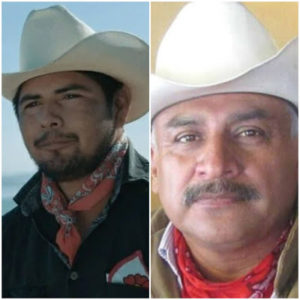Yaqui water defender murdered
June 12, 2021
BEATRIZ GUILLÉN Mexico – 12 JUN 2021 – 04:13 CEST
El Pais
LABERINTO YO’EME Crime has once again shaken the battered Yaqui tribe.
Environmental defender Luis Urbano was murdered this week in downtown Ciudad Obregon, Sonora.
Less than two weeks ago Tomás Rojo, one of the community’s historic leaders, disappeared while out for a morning walk in Vícam, near Cajeme.
There is still no trace of him. Both activists were involved in the defense of water and territory against organized crime and federal and state authorities.
These aggressions are further evidence of the plight of this tribe, known for its long struggle to protect the Yaqui River and its lands. Urbano was shot and killed Tuesday as he was leaving an ATM to withdraw money.
The 36-year-old activist was in charge of accompanying traditional Yaqui authorities. Defined as a hard-working young man, always in a good mood and much loved by his community, Urbano gradually became an interlocutor for the tribe’s demands and petitions, focused on identity and environmental defense.
In 2015, Urbano participated in a national caravan for the defense of water and territory. Before hundreds of people at the Xochimilco Sports Center in Mexico City, he made clear the risks posed to his community by the increasingly bloody struggle for water: “What I saw in this tour is that we are still being trampled, mistreated. Thousands of us are about to fall into marginalization and poverty will worsen due to structural reforms”.
MORE INFORMATION Abel Murrieta, lawyer for the massacred LeBarón family, murdered in Sonora Last year, the environmental defender participated in the documentary Labyrinth Yo’eme about the resistance of the Yaqui people to the diversion of water and the advance of organized crime in their territory.
Sergi Pedro Ros, director of the film and friend of Urbano and Rojo, identifies these two crimes as an example of the permissiveness of the violence suffered by the Yaqui tribe with total impunity.
“Far from stopping, this violence is increasing. And it is extremely serious,” Pedro Ros told EL PAÍS. The filmmaker recalls that Luis Urbano was very concerned about the disappearance of Tomás Rojo. The two activists were contemporaries and both have been “deactivated” at the same time.
“The message seems to be directed to everyone, but not only to the Yaqui tribe, but to all environmental defenders in Mexico,” he says. The director does not know the motivation or relationship between the two crimes, but he does believe that they were being targeted for being what they were: Yaqui.
“Because they are the owners of their land, they are indigenous people in Sonora, and it seems that this cannot be tolerated,” he says. The eight Yaqui villages are home to about 40,000 inhabitants. The majority, 12,000, live in Vícam. All are supplied by a system of three dams that feed the Yaqui River.
The fight for water goes back a long way and the intensity has varied over the years. In 1940, when there was only one dam, La Angostura, President Lázaro Cárdenas granted half of the water to the Yaquis. Over time, two more were built, El Novillo and La Oviachic. The expansion of water infrastructure has not improved the community’s outlook.
“Because of corruption, more water rights have been issued than the watershed has the capacity to support. Many of these concessions are not even used, but rather serve to speculate and then acquire land use rights to make housing developments or things like that,” Yaqui leader Mario Luna explained to EL PAÍS.
In recent weeks the pressure on the community has escalated. The murder of Agustín El Roque Váldez, son of a historic Yaqui leader from Loma de Guamúchil, was followed in early May by the disappearance of Tomás Rojo and then the murder of Urbano.
An established leader and spokesman for the community, Rojo was politically persecuted during the six-year term of former governor Guillermo Padrés (2009-2015), when the so-called war for water in Sonora took place. This struggle was exacerbated by the construction of the Independencia aqueduct, prepared to carry millions of cubic liters from the Yaqui River to Hermosillo, the state capital.
The Yaquis protested because this overexploitation of resources did not guarantee water for their villages. It left them thirsty in the middle of the desert.
Continue reading article at
EL PAIS
El Pais
Translation online by Deepl

SONORA The murder of Yaqui defender Luis Urbano shows once again the danger of the struggle for water in Sonora. This crime follows the disappearance just two weeks ago of community leader Tomás Rojo. Both were involved in environmental defense against federal and state governments.